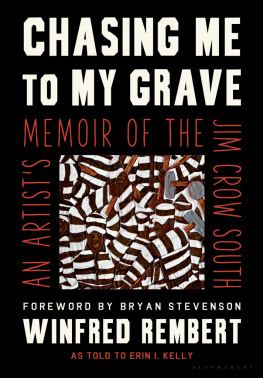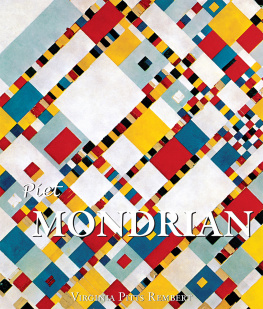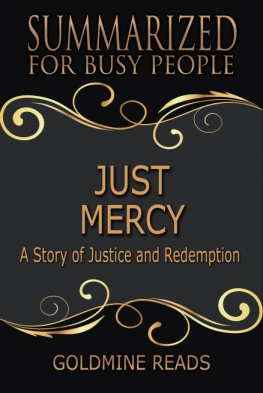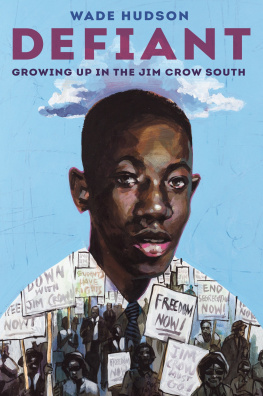PRAISE FOR
CHASING ME TO MY GRAVE
Remberts art expresses the legacy of slavery, the trauma of lynching, and the anguish of racial hierarchy and white supremacy while illuminating a resolve to fight oppression and injustice. He has the ability to reveal truths about the human struggle that are transcendent, to evoke an understanding of human dignity that is broad and universal.
Bryan Stevenson, New York Times bestselling author of Just Mercy and founder/executive director of the Equal Justice Initiative
The power of Remberts Chasing Me to My Grave is in the unvarnished truth, in the writing, the storytelling, the artwork, his life. Unvarnished literary and visual power.
Carol Anderson, New York Times bestselling author of White Rage and One Person, No Vote
Winfred Rembert paints a world too little depicted and a reality we cant afford to forget. While testifying to this nations long history of racial injustice, Chasing Me to My Grave is also a must-read story of Black struggle, solidarity, and love.
Albert Woodfox, author of Solitary
At turns harrowing and haunting, Chasing Me to My Grave is a testament to the rich cultural resources and the poetry of Black Southern life. Remberts paintings, brilliantly composed, kinetic, and enchanting, are interspersed through his reflections about life in the cotton and carceral South. The language is elegant and vernacular, his observations are insightful and poignant. And through it all, joy, no matter how elusive, never disappears.
Imani Perry, Hughes-Rogers Professor of African American Studies at Princeton University and author of Looking for Lorraine: The Radiant and Radical Life of Lorraine Hansberry
Chasing Me to My Grave is both a literary and artistic triumph. Winfred Remberts memoir of the carceral state in the Jim Crow South is a profoundly moving, devastatingly painful, and wonderfully transformative experience. Remberts earthy prose, evocative images, and grace in the face of racial oppression is an inspiring true story that will forever change the way we look at the system of mass incarceration and unequal justice and those who resisted with love, beauty, and artistic brilliance. This book is a must read for all who are interested in finding out the roots of our current racial crisis as well as the possibilities for truth, justice, and healing.
Peniel C. Joseph, author of The Sword and the Shield: The Revolutionary Lives of Malcolm X and Martin Luther King Jr.
Chasing Me to My Grave is a brilliant reminder of where weve come from as a country. Weve come to accept William Faulkners adage, The past is never dead. Its not even past. But Remberts account reminds us that it is in the remembering of the past that we keep it from becoming prologue. From the Jim Crow South to the chain gang to a life as an artist, Rembert reminds us of the terror and the possibility of America. That he became an artist while in prison says something about the gifts we bury, that he lived to tell this harrowing tale says something about the strength of this man.
Reginald Dwayne Betts, author of Bastards of the Reagan Era and Felon
CHASING ME TO MY GRAVE

BLOOMSBURY PUBLISHING
Bloomsbury Publishing Inc.
1385 Broadway, New York, NY 10018, USA
This electronic edition published in 2021 by Bloomsbury Publishing Plc
BLOOMSBURY,
BLOOMSBURY PUBLISHING, and the Diana logo are trademarks of Bloomsbury Publishing Plc
First published in the United States 2021
Text copyright Winfred Rembert and Erin I. Kelly 2021
Artwork Winfred Rembert/Artists Rights Society (ARS), New York 2021
Foreword copyright Bryan Stevenson 2021
Lyrics from Lady My Whole World Is You () by Paul Lawrence Kelly Copyright 1984 by Peermusic III, Ltd., Malaco Music Co., Kelly World Music Peermusic III, Ltd. administers on behalf of itself, Malaco Music Co., Kelly World Music. All Rights Reserved. Used by permission.
All rights reserved
You may not copy, distribute, transmit, reproduce or otherwise make available this publication (or any part of it) in any form, or by any means (including without limitation electronic, digital, optical, mechanical, photocopying, printing, recording or otherwise), without the prior written permission of the publisher. Any person who does any unauthorised act in relation to this publication may be liable to criminal prosecution and civil claims for damages.
ISBN: 978-1-6355-7659-7 (PB)
ISBN: 978-1-6355-7660-3 (eBook)
Library of Congress Cataloging-in-PublicationData is available
To find out more about our authors and their books please visit www.bloomsbury.com where you will find extracts, author interviews and details of forthcoming events, and to be the first to hear about latest releases and special offers, sign up for our newsletters.
Bloomsbury books may be purchased for business or promotional use. For information on bulk purchases please contact Macmillan Corporate and Premium Sales Department at .
To Mama, who held out her hands and took me
CONTENTS
by Bryan Stevenson
On a quiet Sunday afternoon in September 2013, I walked into the nearly empty Montgomery Museum of Fine Arts in Alabama. A colleague had told me I would find something extraordinary there, so I went. At the time, Id lived in Montgomery for nearly twenty-five years and I dont think Id been in that space more than once or twice.
I will never forget what I saw in the museum that day.
The art of Winfred Rembert stunned and silenced me. His paintings moved and overwhelmed meit was an emotional experience I never expected. I saw the color and narrative construction of Jacob Lawrence in Mr. Remberts work. A brilliant geometry of compelling scenes and dazzling ideas brought to mind Faith Ringgold or Charles Alston. I saw craft, skill, and originality in Mr. Remberts use of stretched leather for a canvas. I thought of Elizabeth Catlett, Kerry James Marshall, and Carrie Mae Weems, but Mr. Remberts work was unique. As I continued through the exhibit, what shook me most was the pain, the anguish, and the suffering he captured. But there was also love, strength, humor, and the power and complexity of the Black experience in America distilled into some of the most compelling art Ive seen.
I initially thought that my strong response to Mr. Remberts paintings was sparked by the evocative scenes depicting life in prison. Ive spent my entire career in Southern jails and prisons, on death row with the condemned, behind locked doors and barbed wire. Ive gone inside hundreds of cages where people have been sent to die; Ive witnessed how people try to survive despite the brutality of captivity. Mr. Remberts exhibit captured the weight and burden of imprisonment so powerfully.
But the longer I studied the paintings, the more I realized that what I saw went beyond insights into incarceration. Mr. Remberts art expresses the legacy of slavery, the trauma of lynching, and the anguish of racial hierarchy and white supremacy while illuminating a resolve to fight oppression and injustice. He has the ability to reveal truths about the human struggle that are transcendent, to evoke an understanding of human dignity that is broad and universal.
On that Sunday, Mr. Remberts art converted a conventional, quiet museum in Montgomery into something that felt like a dynamic Black church: a place of confession and repentance leading to redemption and salvation.








